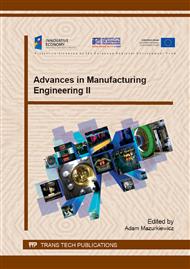p.3
p.9
p.15
p.21
p.27
p.34
p.41
p.47
The Study on Erosive and Abrasive Wear Resistance of Different Multilayer Coatings Obtained on Titanium Alloy Ti6Al4V
Abstract:
One of the areas in which increased durability is of particular significance is the use of machine elements in conditions of intensive exposure to erosive wear, for example, turbine blades of aircraft engines and power turbines in ventilation systems, and machine elements working in a dusty environment. As it is apparent from the analysis of the state of the art, high possibilities to increase the erosive and abrasive wear resistance of machine elements are created by appropriately designed coatings and layers, especially multilayer coatings composed on the base of materials with different plasticity properties. This is associated with particular characteristics of this type of multilayer coatings that allow the absorption of external energy reaching the surface without causing permanent damage to the coating, while significantly reducing the erosive wear rate.The article presents the results of material research and the results of erosion test of three different materials solutions of surface engineering, i.e. multilayer coatings (Cr / CrN) x8, (TiN / ZrN)multinano and a (Ti-Al) intermetallic / AlCrTiN hybrid layer, obtained on titanium alloy Ti6Al4V. The (Cr / CrN) x8 and (TiN / ZrN)multinano multilayer coatings were obtained by arc evaporation, and the (Ti-Al) intermetallic / AlCrTiN hybrid layer was prepared using a hybrid technology combining diffusion saturation in aluminium powders and arc evaporation in a single technological process. The selected material solutions of the surface layer were subjected to the analysis of the structure by scanning electron microscopy (Hitachi 3000). Measurements of hardness and Young's modulus were conducted using the nanohardness Tester CSM. The results of this study allowed the authors to compare the erosive wear resistance and wear resistance of selected material solutions, and this led to the conclusion that the (Ti-Al) intermetallic / AlCrTiN hybrid layer is the most effective solution.
Info:
Periodical:
Pages:
9-14
Citation:
Online since:
August 2015
Keywords:
Price:
Сopyright:
© 2015 Trans Tech Publications Ltd. All Rights Reserved
Share:
Citation:


